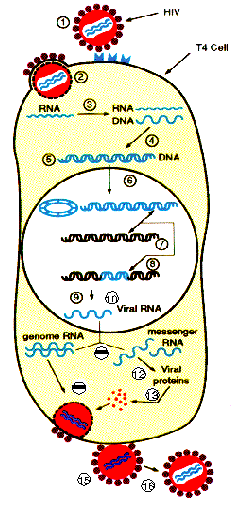| HIV
infection begins with the attachment (1) of the virion to the susceptible
host cell by binding of the virion gp120 surface protein and the host
cell CD4 receptor. This recognition allows fusion of the virion protein
coat with the host cell membrane followed by the passage of virion contents
into the host cell cytoplasm (2) Within the host cell cytoplasm, the RNA
undergoes Reverse Transcription (3), assisted by the viral catalytic enzyme
Reverse Transcriptase
to form a DNA-RNA hybrid. RnaseH then degrades the RNA component (4) as
Reverse Transcriptase synthesizes the second strand of DNA (5). After
this conversion of RNA to DNA, the DNA transfers into the cell nucleus
(6). The viral DNA integrates into the host DNA enabled by Integrase,
another viral catalytic enzyme, to produce the provirus (7). The provirus
is now under obligatory conditions of the host cell. HIV may remain in
latency for years (8), and then undergo late transcription (10), which
gives reason for life-long anti-viral treatment. The provirus DNA may
continue into early transcription to produce RNA, enabled by the host
cell's mechanism (9). The RNA is transported to the cell cytoplasm for
translation to polypeptides and further protein synthesis (11,12). The
proteins proceed through glycosolation in preparation for viral assembly
(13). Viral proteins, the intermediate gag-pol polypeptide, and two strands
of viral RNA migrate to the cell membrane where assembly of the virion
occurs(14). As the immature, virion buds from the host cell taking host
cell membrane with it (15), HIV-1 Protease cleaves the gag-pol polypeptide
into functional proteins thus giving rise to an infectious HIV-1 virus
(16). |
